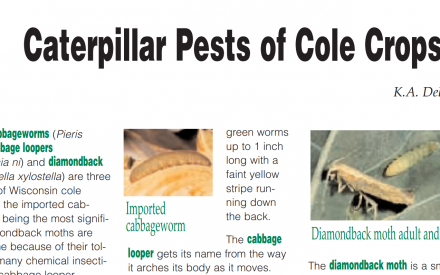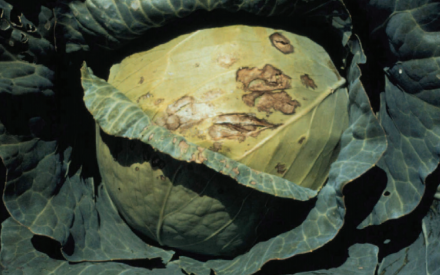
What is black rot?
Black rot is a potentially lethal bacterial disease that affects cruciferous vegetables such as broccoli, Brussels sprouts, cabbage, cauliflower, kale, rutabaga and turnip, as well as cruciferous weeds such as shepherd’s purse and wild mustard. Black rot occurs worldwide wherever cruciferous plants are grown and makes cruciferous vegetables unfit for the marketplace or the table.
What does black rot look like?
Black rot symptoms may not develop for more than a month after cruciferous vegetables start to grow. Initial symptoms are irregular, dull, yellow blotches that appear on the edges of leaves. As the disease progresses, these blotches expand into V-shaped areas with the wide part of the “V” at the edge of the leaf and the point of the “V” toward the attachment point of the leaf to the plant. The V-shaped areas are initially yellow, but eventually become brown and necrotic (i.e., dead) in the center with a yellow border or halo. Veins in affected areas are brown or black, forming to a net-like pattern (often most visible when leaves are held up to the light). Later, interior stem tissue (specifically the water conducting tissue) will also turn brown or black. At this point, affected plants tend to show symptoms of wilting. Black rot can also predispose vegetables to other rot diseases such as bacterial soft rot.
Where does black rot come from?
Black rot of crucifers is caused by Xanthomonas campestris pv. campestris (Xcc). This bacterium is most often introduced into a garden on or in seeds and transplants of susceptible vegetables. By some estimates, a single infected seed in 10,000 can lead to a severe outbreak of the disease if environmental conditions are favorable. Favorable conditions include warm temperatures (approximately 80°F) and high humidity. Once introduced into a garden, Xcc can survive in residues from susceptible vegetables or on weed hosts. Xcc can subsequently enter susceptible plants through roots, through natural openings in leaves or through wounds made by tools, rough handling, or insect feeding. Cruciferous plants grown near infected plants and healthy plants handled with the same tools as diseased plants are at highest risk of becoming infected.
How do I save a plant with black rot?
There are no curative treatments available to combat black rot once the disease has occurred. However, when disease severity is low, copper-containing fungicides/bactericides that are labeled for use on cruciferous vegetables may help limit additional disease. See Home Vegetable Garden Fungicides for specific products. Be sure to read and follow all label instructions of the fungicide that you select to ensure that you use the product in the safest and most effective manner possible. At harvest, vegetables with low levels of black rot may be salvageable. Remove symptomatic leaves (or other plant parts) and store the remaining parts of the vegetables in a cool but not overly wet environment.
How do I avoid problems with black rot in the future?
Prevent introduction of Xcc into your garden by using certified disease-free crucifer seeds and transplants. If certified disease-free seed is not available, use hot water seed treatments to eliminate Xcc. See Hot-Water Seed Treatment for Disease Management for details on this process and the proper temperature and treatment time for specific types of crucifer seeds. Do not plant cruciferous vegetables in the same area of your garden every year; rotate (i.e., move) these vegetables to different locations within your garden. For more information on rotation see Using Crop Rotation in the Home Vegetable Garden.
Once your cruciferous vegetables are growing, be sure to fertilize them appropriately. In particular, inadequate nitrogen can predispose plants to black rot. Also, be gentle with cruciferous vegetables to prevent any wounds that might serve as entry points for Xcc. Do not use a sprinkler to water your vegetables as this can splash Xcc from plant to plant. Instead, use a soaker or drip hose that applies water directly to the soil. Avoid working with plants when they are wet to help limit spread of Xcc. If severe black rot develops, promptly remove symptomatic plants as well as all cruciferous plants within a three to five foot radius. Dispose of these plants by burning (where allowed by local ordinance), burying or composting them. If you decide to compost, make sure your compost pile heats to a high enough temperature and that any infested material decomposes for at least one year before it is reincorporated into your garden.
Finally, decontaminate any pots, tools, or other gardening items that have come into contact with Xcc-infected plants or Xcc-infested debris by treating them for at least 30 seconds with 70% alcohol (preferable for metal tools because of its less corrosive properties) or 10% bleach. Rubbing alcohol and many spray disinfectants typically contain approximately 70% alcohol. If you use bleach on metal tools, be sure to thoroughly rinse and oil them after use to prevent rusting.
For more information on black rot:
Contact the University of Wisconsin Plant Disease Diagnostics Clinic (PDDC) at (608) 262-2863 or pddc@wisc.edu.
Authors: Andrew Pape*, UW-Madison Plant Pathology
Last Revised: 02/28/2028
D-number: D0019
*Completed as partial fulfillment of the requirements for Plant Pathology 558 at the University of Wisconsin Madison.
References to pesticide products in this publication are for your convenience and are not an endorsement or criticism of one product over similar products. You are responsible for using pesticides according to the manufacturer’s current label directions. Follow directions exactly to protect the environment and people from pesticide exposure. Failure to do so violates the law.
Thanks to Amanda Gevens, Donna Henderson, Chelsea King, Tami Pape, Craig Saxe and Brenden Sheehy for reviewing this document.
A complete inventory of UW Plant Disease Facts is available at the University of Wisconsin-Madison Plant Disease Diagnostics Clinic website: https://pddc.wisc.edu.
Send a Plant Sample for Analysis
Be cautious when self-diagnosing plant health issues. Very few diseases can accurately be diagnosed by eye.
Contact the UW Plant Disease Diagnostics Clinic (PDDC), and for a small fee, clinic staff can examine a plant, determine the cause of the disease/disorder, and provide advice on how to control or prevent the issue.
Download Article





 Caterpillar Pests of Cole Crops
Caterpillar Pests of Cole Crops Growing Broccoli, Cauliflower, Cabbage, and Other Cole Crops in Wisconsin
Growing Broccoli, Cauliflower, Cabbage, and Other Cole Crops in Wisconsin Cole Crops Disorder: Clubroot
Cole Crops Disorder: Clubroot Cole Crops Disorder: Blackleg
Cole Crops Disorder: Blackleg


